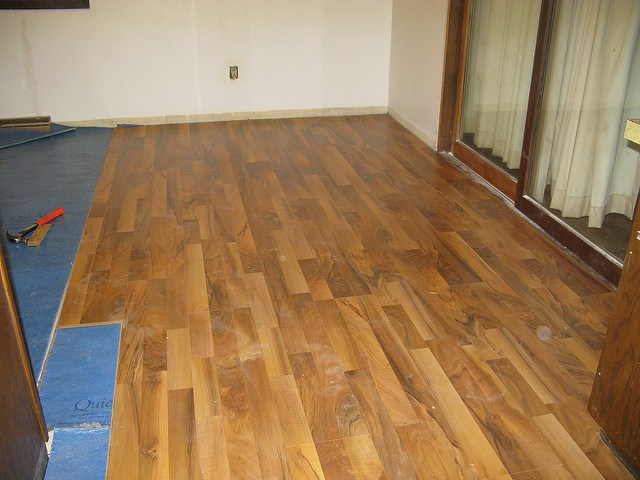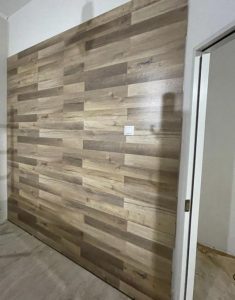Laminate flooring has taken over a large percentage of the wood flooring market. Although not an actual wood product, it is often seen as such, because it is made to look like wood. But much like the imprinted wood grain vinyl which is used in low-cost furniture, laminate flooring is only printed to look like wood; it is not normally wood.
On the other hand, true hardwood floors or even engineered hardwood floors are all wood. The basic difference between these two is that solid wood floors are ¾” thick planks of wood, which have been tongue and grooved so that they can interlock during installation. Engineered hardwood floors laminate a thin layer of hardwood to a plywood substrate, which is then cut with the tongue and groove for installation.
Laminate floors offer a more cost-effective, while still attractive solution for those who need to be budget-conscious about their home décor. It gives them the ability to have the appearance of hardwood floors, without the expense.
However, there is a definite difference in quality between these products. While laminate floors are made to look like hardwood floors, and do a pretty good job of it, they are not. The imprinted layer of the laminate is thin and can become damaged or worn. In contrast to this, engineered hardwood floors can be lightly sanded and refinished a couple of times and hardwood floors can be heavily sanded and refinished several times over. This difference increases the importance of protecting laminate floors.
Many homeowners wonder if it is recommended to seal laminate floors. The short answer is “yes,” but there’s a lot more to this task than simply picking up a basic can of sealer and painting it onto your new laminate. When properly sealed, laminate floors resist spills better and offer greater durability. This means a better, longer-lasting floor for you to enjoy through the years to come.
Sealing Laminate Floors: The Pros and Cons
This quick list of pros and cons will help you decide whether you’d like to leave your installation as-is, or go forward with the task of applying sealant to laminate flooring.
Pros
- The right sealant provides excellent spill protection.
- When you seal laminate floor expansion spaces in kitchens and bathrooms, there’s less risk of subfloor damage in the event of a large spill or leak.
- Sealant is inexpensive.
- It’s easy to apply sealant to a laminate floor.
Cons
- Some laminate flooring brands are not designed to be sealed.
- Laminate floors can be slippery and dangerous when sealant is applied to the entire floor.
- When sealant is applied to laminate flooring against manufacturer’s recommendations, the floor warranty may be voided.
The sealing process starts with the installation of the flooring. You should always use a PVA Type II glue when installing laminate flooring. This provides sealing for the space between planks. Always buy this adhesive in a bottle with a nozzle, as this allows you to regulate how much adhesive comes out. You don’t want it coming up between the seams, to the point where it is visible on the surface of your floor.
Never apply floor sealant over a floor that has been waxed; the sealant will not stick. If the floor has ever been waxed, the wax will need to be fully removed, before any sealant can be applied. Normal floor-stripper can be used to remove the wax. Just be sure to do a thorough job, as the wax might not come up with the first application of stripper.
Just the Edges!
There are a few guides out there which recommend applying a coat of waxy polish or sealant to an entire laminate floor. While there may be some brands of laminate that work with this type of sealant, most manufacturers recommend avoiding the application of sealant to an entire laminate floor. The reason for this is that the majority of laminate flooring brands are manufactured with a thin layer of plastic materials covering the layer with the wood grain pattern on it. This top layer is already moisture-resistant, making it non-porous, so there is nothing for the sealant to absorb into and bond with. The fiberboard cores are usually protected with polymers and waxes, and once the laminate pieces have been properly locked together, moisture won’t penetrate into the core.
Now that you know that you’re off the hook when it comes to sealing the entire floor, which portions of your laminate flooring need sealant?
The answer depends on the floor location and the likelihood of spills. Most manufacturers recommend sealing the perimeter of the laminate floor, at least in areas where spills might occur. Sealing the perimeter prevents water from reaching the edge of the floor and making its way underneath the laminate boards, where it might be absorbed by the core. If this happens, swelling and damage can occur, and this can ultimately lead to the need for a costly replacement.
In addition, you might want to seal the seams in high-spill areas, like the area in front of a sink. While this is not absolutely necessary, it will increase the life of the flooring, which is the whole purpose of the exercise. Clear silicone caulking is better for sealing any seams in laminate flooring, than polyurethane is, providing a waterproof seal that will probably outlast the flooring itself.
Essential Materials
There are two basic types of sealants used for laminate floors: silicone caulking and polyurethane coating. Before choosing to use either, it is a good idea to check the information provided by the flooring manufacturer, to see what is compatible with the floor. There are specialty laminate sealers available as well. For example, Pergo offers floor sealant in different colors to match the laminate that it offers. These sealants aren’t compatible with all of Pergo’s flooring choices, though. Most brands are compatible with 100 percent silicone caulk; buy may not be compatible with other sealers.
Please note that you should buy sealant with a sheen that matches the finish on your floor. If you use a flat urethane finish on a floor with a high-gloss coating, it will be obvious and make it look like the edges of your floor are dirty.
The tools you’ll need will depend a lot on the kind of sealant you are using. Silicone caulk will require a caulk gun to apply sealant to laminate floors, as well as a putty knife to remove excess caulking. Polyurethane sealants should be brushed on, as you would when finishing architectural trim.
Some people choose to use a paint roller, rather than a brush for applying polyurethane finishes. This can be done, but you need a short-nap roller to apply it, preferably a mohair whizz roller. Many people recommend foam rollers for urethane finishes, but they tend to generate a lot of bubbles.

How to Seal Laminate Flooring the Right Way
The best way to seal laminate floors is to start by removing any baseboards that might be in place, so that your sealant can also protect the edge of the laminate that borders the expansion space between the laminate and the structure next to it. This also provides more security for the sealant as well, giving it something to grip to, rather than just having it sit on top of the laminate where it’s likely to peel off.
- Be sure to read the instructions on the laminate floor sealant container, before beginning. You should find notes about pre-cleaning the floor, ensuring that the surface is completely dry before getting started, and perhaps some information about working within an optimal temperature range.
- If you need to remove baseboards, be sure to do so carefully, so that it can be reinstalled. If the baseboard is painted, you may need to cut the paint and caulking with a utility knife, where the baseboard meets the wall, as well as where it meets other pieces of baseboard and door casing.
- Use a straight prybar with a thin block of plywood wedged between the prybar neck and the wall to pull the baseboard off. Slowly start to pull the baseboard away from the wall using even pressure. Move along the edge of the baseboard and loosen the entire piece before removing it from the wall. Mark the back of the baseboard, so that you will know where to reinstall it. If the baseboard doesn’t have an obvious contour to show which side goes up, mark and arrow pointing up on the back side as well.
For using urethane or polyurethane sealants
- When the floor is ready, open your sealant. Using a small, natural bristle brush, apply a line of sealant all the way around the perimeter of the room, being sure to cover the entire area that will be covered by the baseboard, as well as at least ¼” out from the baseboard.
- Repeat this all around the room. Be sure to use extra care with sealing the areas around cabinets and doorjambs, particularly when those doorjambs lead to the outside, or join up with a space such as a bathroom or laundry room, where there is a greater likelihood that moisture might make its way onto the laminate. Take extra care to seal all around plumbing fixtures, too. Ensure that you seal all around toilet bases, sink bases, bathtubs, and shower enclosures. In the kitchen, ensure that you coat the are where the laminate floor meets up with the base of the dishwasher or its pedestal. If your refrigerator has a water line, seal that area as well.
- If you are sealing the seams between boards, do this once you have completed the perimeter. Plan out your work, so that you don’t paint yourself into a corner. Your small brush should be narrow enough to allow sealing the seams, without painting over the majority of the board. Take time to be neat, as you only need a thin line of sealant at the seam, not to cover half the board.
For using silicone caulk
- For sealing with silicone caulking, you’ll want to cut the smallest possible hole in the end of the caulk tube. Squeeze out the caulking, while running it over the seam, using the seam itself as a guide for the caulking tube.
- Go back over the caulking with a wet finger, gloved finger (rubber glove), or putty knife to smooth out the caulking and remove excess. You don’t want to end up with any caulking sticking up above the level of the floor, especially in the middle of the room.
For both types of sealant
- Remove floor vent covers and seal the area between the edge of the laminate flooring and the subfloor. Let the sealant dry per the manufacturer’s instructions before replacing the vent covers. This way, you won’t damage the sealant next time you remove the vent covers for cleaning.
- When the sealant is dry, replace your baseboards. It is not advisable to reuse nails, as there is a high probability of them bending during the removal process. Baseboard is usually installed with 18 ga. 2” finish nails.
- Once the baseboard is reinstalled, putty the nail holes, allow the putty to dry and then apply another coating of paint or varnish to the baseboard to seal it and hide the fact that the baseboard has been removed and reinstalled.
How Much Time Does It Take to Seal Laminate Floors?
This is a quick project! Depending on the size of your room, expect to spend an hour or two, minus any additional time needed for the sealant to dry.
What is the Average Cost of Sealing Laminate Flooring?
Laminate floor sealant is fairly inexpensive, as is silicone caulk. Depending on the size of your project and the sealant brand you choose, expect your cost to begin around ten to fifteen dollars.
That’s it! You’ve sealed your laminate flooring and it now has extra protection from moisture that might make its way under the edges. Be sure to double-check the label on the sealant to determine if reapplication is ever required, and if so, how often it should take place.



